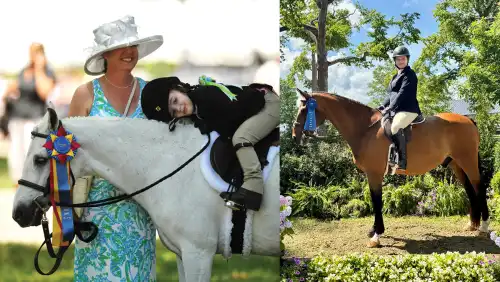General George Patton Jr.
December 26, 1945
The sporting world lost one of its best-known followers in the death of Gen. George S. Patton Jr. last week. After a life of participation in sports and especially with horses, Gen. Patton died as the result of an automobile accident. He not only was connected with horses during his Army career but in private life he had ridden races, shown horses and was MFH of the Cobbler Hunt at Delaplane, Virginia. Last year at this time everyone was
following avidly his gigantic task in the “Battle of the Bulge,” where he proved once again what a great leader he was.
Col. John W. Wofford
March 4, 1955
A sad loss to the world of equestrian sports is occasioned by the death on February 27th of Col. “Gyp” Wofford, retired army officer, Olympic rider, master of foxhounds, teacher of American horses and riders in the Olympic Games of the future.
Selected for the Army Horse Show Team by Gen. Chamberlin in 1929, his three years was climaxed in the Olympic Games in 1932, in which he rode on the Prix de Nations Jumping Team.
From 1950-1952 “Gyp” Wofford, as president of the U.S. Equestrian Team, carried the team through the training for and competition in the 1952 Olympic Games in Helsinki, Finland. To him belongs credit for the success of the first civilian team to represent the United States. In 1953 he was elected to the executive committee of the Federation Equestre Internationale as a representative of this country.
USET Equitation Class
April 30, 1965
This year the U.S. Equestrian Team is introducing a new equitation class designed to fill the gap for those juniors who qualify for the “Medal” and the “Maclay” early in the year and have no further incentive to keep showing in horsemanship. Called the USET Equitation Class, it is an advanced class open to junior members of the USET who have not reached their 18th birthday.
Winners of twenty USET Equitation classes will receive a gold pin. In addition, the two junior members who win the most USET Equitation Classes during 1965 will be invited to spend a week with the Team at its Training Center in Gladstone, New Jersey.
ADVERTISEMENT
Suggested Jumper Rule Changes
Ben O’Meara
November 12, 1965
I shall attempt to take an objective view of the ills of show jumping and suggest some cures. It is, of course, a difficult, if not impossible task to satisfy everyone connected with this sport. I believe we must then seek an objective beneficial to the sport of jumping itself. The obvious objective is to raise the standard of show jumping. To this end I have prepared five proposals to radically, yet simply, alter the format of the jumper division.
The proposals are: eliminate jumper championships; eliminate any form of jumper awards based on accumulated points; restrict the green jumper division to novice horses, scored completely by Table I with time allowance; score the open jumper division completely by FEI rules, properly administered; and abolish poling.
International Combined Training Crosses the Atlantic
Commentary by Alexander Mackay-Smith
July 4, 1975
The most significant international three-day event held in 1975 took place at Ledyard [Mass.] last weekend, partly because of the cancellation of Badminton
in April. Under the leadership of U.S. Combined Training Association President Neil Ayer, the Ledyard event was organized and carried through in a manner which wholly corresponded to its world-class position.
Neil Ayer became president in 1971, and since then the organization has grown from strength to strength. Certainly Ledyard ’75 is to date its greatest achievement in competitive organization.
In 1976 the great competition of combined training will be the three-day event of the Montreal Olympic Games, while the next competition of international importance will be the World Championships, to be held in the United States because of our gold medal won at Burghley [England] last summer.
So from 1975 to 1978 international combined training will be centered on this side of the Atlantic Ocean.
Chrysler Gladstone Driving Event
John Strassburger
September 27, 1985
ADVERTISEMENT
In only four years the Gladstone Driving Event has become one of the most important fixtures on the driving calendar, and this year’s renewal was by far the biggest. No expense was spared by the Gladstone Equestrian Association, of which Finn Caspersen, the chairman of the board of Beneficial Management, owners of the grounds of the USET headquarters, is an important member.
With the help of the Chrysler Corporation, they paid expenses for Tjeerd Velstra [the former World Champion from The Netherlands who owns the four-in-hand competition], Jan Erik Pahlsson of Sweden, [second in the four-in-hand division], and Laszlo Juhasz of Hungary.
In addition, there was a large budget for publicity. Approximately 10,000 people paid to see the competition, and there was a tremendous amount of media coverage.
Col. Donald Thackeray
February 10, 1995
Col. Donald Thackeray, one of the most popular dressage judges in the country and a distinguished administrator around the world, died on Feb. 4 of complications from pneumonia.
Col. Thackeray was one of the many military men who shaped American equestrian sports after World War II. He held the Federation Equestrian International’s highest O rating as a judge in dressage, driving, three-day and jumping and was a member or chairman of numerous influential committees for the FEI, American Horse Shows Association, and U.S. Equestrian Team.
Although Col. Thackeray was the chairman of the USET Dressage Planning Committee, driving benefited more than any other horse sport from his influence. He helped write the international rules for combined driving. In 1987 he stepped down as the chairman of the FEI Driving Committee after 10 years and at the same time retired from the FEI Bureau after 17 years.














